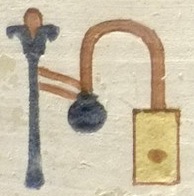



This page displays details of the selected Monument. Click on the Monument number to list all individual signs ("occurrences") recorded from that object or structure.
Monument : Ankhmerire
Period : Dynasty VI
Reign(s) : Pepy I
High Date : 2321
Low Date : 2287
Monument type : Mastaba
Localisation or provenance : Saqqara
References : PM III, 2, 621-622; Altenmüller (1998).
These inscriptions are from an offering room in the mastaba of Mehu (Mon.13). Ankhmerire was “Inspector of prophets of the Pyramid of Pepy I”. The occurrences are taken from the list provided in Altenmüller (1998, 264-266) and the images are from Tafel 103 and 104 in the same work. The colours are in many cases faded, but enough remains to give a reasonable idea of the original shades. Not all signs noted by Altenmüller have been included in the database as over sixty images of individual hieroglyphs are available on the colour plates. Some descriptions have been rectified, where necessary, for example U23 where no trace of a black blade can be seen on any of the three samples from Tafel 103. Some sign numbers have been changed, such as Altenmüller’s Aa15 which has been changed to the more accurate Old Kingdom form of Aa14. Some new signs have been added to the list, for example T28 which occurs four times on the colour plates but not in the descriptive lists. It should be noted that Altenmüller does not claim to have provided a full list of all polychrome hieroglyphs but merely a representative sample (1998, 264). Interestingly, for this early date, the inscriptions have been painted on a blue-grey background, somewhat similar to that of the KV57 tomb of Horemheb (Mon.25). However, no attempt has been made to provide a colour contrast between blue signs such as O1 and the background, sometimes rendering these signs unclear. A comparison with the contemporary mastaba of Mehu (Mon.13), which is also the physical location of the mastaba of Ankhmerire, shows that, of the 31 signs found in both monuments, 23 adopt the same colour scheme. This represents 74% of the sample and, together with the similar comparison (see Mon.13) between Mehu and Idout (Mon.24), points convincingly to a stabilisation of the canon by the end of the Old Kingdom.